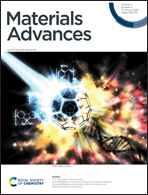Theoretical design of two-dimensional AMInP2X3Y3 (AM = Li, Na, K; X/Y = S, Se, Te) monolayers for highly efficient excitonic solar cells†
Abstract
Two-dimensional materials are regarded as promising candidates for use in photovoltaic solar cells. On the basis of first-principles calculations, we show that the 2D alkali metal indium phosphorus trichalcogenides AMInP2X3Y3 (AM = Li, Na, or K; X/Y = S, Se, or Te) monolayers possess excellent stability and great potential for solar energy conversion applications. The cohesive energies, phonon spectra, and elastic constants of these materials demonstrate their high thermodynamic, kinetic, and mechanical stabilities. The 2D NaInP2Te6 (NT), KInP2Te6 (KT), and AMInP2Te3Se3 (LTS,NTS, and KTS) monolayers are promising donor materials for excitonic solar cells with high photovoltaic performance. More importantly, the appropriate donor bandgaps and small conduction band offsets of these type II heterostructures result in power conversion efficiencies (PCE) of up to 22.12% (NT/InSe), 18.23% (KT/MoGe2N4), 21.93% (NTS/MoGe2N4) and 18.00% (KTS/T-HfSe2), making them promising candidates for solar energy conversion applications. Our findings reveal the great potential of 2D alkali metal indium phosphorus trichalcogenides for the design of high-performance excitonic solar cells.

- This article is part of the themed collection: Materials Informatics


 Please wait while we load your content...
Please wait while we load your content...